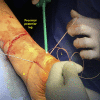A Percutaneous Knotless Technique for Acute Achilles Tendon Ruptures
- PMID: 29552483
- PMCID: PMC5851437
- DOI: 10.1016/j.eats.2017.08.065
A Percutaneous Knotless Technique for Acute Achilles Tendon Ruptures
Abstract
Achilles tendon ruptures are a common tendon injury, usually occurring in middle-aged men during recreational sporting activities. Both nonoperative and operative management are employed to treat these injuries. Several operative treatments are described in the literature, including percutaneous Achilles repair, mini-open repair, and open repair. Open Achilles repair is associated with higher rates of impaired wound healing and infection, whereas minimally invasive techniques have been reported to have an increased risk of iatrogenic sural nerve injury. More recently, low complication rates, improved cosmetic appearance, reduced operating times, and improved clinical outcomes have been reported for the percutaneous Achilles repair technique. In this Technical Note, we present our preferred technique using the Percutaneous Achilles Repair System (Arthrex, Naples, FL), which has been reported to have minimal wound and nerve complications, and early return to activity.
Figures















Similar articles
-
Clinical Outcomes and Complications of Percutaneous Achilles Repair System Versus Open Technique for Acute Achilles Tendon Ruptures.Foot Ankle Int. 2015 Nov;36(11):1279-86. doi: 10.1177/1071100715589632. Epub 2015 Jun 8. Foot Ankle Int. 2015. PMID: 26055259
-
Minimally Invasive Mid-Substance Achilles Tendon Repair Using the Percutaneous Achilles Repair System (PARS).JBJS Essent Surg Tech. 2022 Sep 22;12(3):e21.00050. doi: 10.2106/JBJS.ST.21.00050. eCollection 2022 Jul-Sep. JBJS Essent Surg Tech. 2022. PMID: 36816527 Free PMC article.
-
Hybrid Percutaneous Management of Acute Midsubstance Achilles Tendon Ruptures.Video J Sports Med. 2023 Apr 6;3(2):26350254231152660. doi: 10.1177/26350254231152660. eCollection 2023 Mar-Apr. Video J Sports Med. 2023. PMID: 40309421 Free PMC article.
-
Minimally Invasive Treatments of Acute Achilles Tendon Ruptures.Foot Ankle Clin. 2019 Sep;24(3):399-424. doi: 10.1016/j.fcl.2019.05.002. Epub 2019 Jun 18. Foot Ankle Clin. 2019. PMID: 31370993 Review.
-
Achilles tendon rupture: physiotherapy and endoscopy-assisted surgical treatment of a common sports injury.Open Access J Sports Med. 2010 Dec 13;1:233-40. doi: 10.2147/OAJSM.S10670. Open Access J Sports Med. 2010. PMID: 24198562 Free PMC article. Review.
Cited by
-
Modified Bunnell suture repair versus bundle-to-bundle suture repair for acute Achilles tendon rupture: a prospective comparative study of patients aged <45 years.BMC Musculoskelet Disord. 2020 Aug 26;21(1):580. doi: 10.1186/s12891-020-03588-5. BMC Musculoskelet Disord. 2020. PMID: 32847567 Free PMC article.
-
Jigless knotless internal brace technique for acute Achilles tendon rupture: a case series study.J Orthop Surg Res. 2019 Dec 5;14(1):415. doi: 10.1186/s13018-019-1471-8. J Orthop Surg Res. 2019. PMID: 31806034 Free PMC article.
-
Percutaneous Achilles Tendon Repair Using Ultrasound Guidance: An Intraoperative Ultrasound Technique.Arthrosc Tech. 2023 Jan 18;12(2):e173-e180. doi: 10.1016/j.eats.2022.10.006. eCollection 2023 Feb. Arthrosc Tech. 2023. PMID: 36879876 Free PMC article.
-
Age and Tightness of Repair Are Predictors of Heel-Rise Height After Achilles Tendon Rupture.Orthop J Sports Med. 2020 Mar 25;8(3):2325967120909556. doi: 10.1177/2325967120909556. eCollection 2020 Mar. Orthop J Sports Med. 2020. PMID: 32232072 Free PMC article.
-
Open versus minimally-invasive surgery for Achilles tendon rupture: a meta-analysis study.Arch Orthop Trauma Surg. 2021 Mar;141(3):383-401. doi: 10.1007/s00402-020-03437-z. Epub 2020 Apr 7. Arch Orthop Trauma Surg. 2021. PMID: 32266518
References
-
- Huttunen T.T., Kannus P., Rolf C., Felländer-Tsai L., Mattila V.M. Acute Achilles tendon ruptures: Incidence of injury and surgery in Sweden between 2001 and 2012. Am J Sports Med. 2014;42:2419–2423. - PubMed
-
- Hattrup S.J., Johnson K.A. A review of ruptures of the Achilles tendon. Foot Ankle. 1985;6:34–38. - PubMed
-
- Leppilahti J., Puranen J., Orava S. Incidence of Achilles tendon rupture. Acta Orthop Scand. 1996;67:277–279. - PubMed
-
- Wilkins R., Bisson L.J. Operative versus nonoperative management of acute Achilles tendon ruptures: A quantitative systematic review of randomized controlled trials. Am J Sports Med. 2012;40:2154–2160. - PubMed
-
- Barfod K.W., Bencke J., Lauridsen H.B., Ban I., Ebskov L., Troelsen A. Nonoperative dynamic treatment of acute Achilles tendon rupture: The influence of early weight-bearing on clinical outcome: A blinded, randomized controlled trial. J Bone Joint Surg Am. 2014;96:1497–1503. - PubMed
LinkOut - more resources
Full Text Sources
Other Literature Sources

